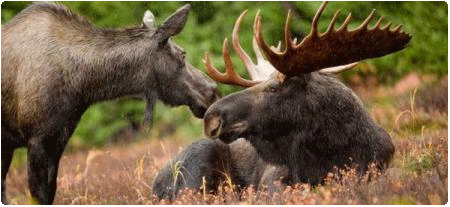The Fish & Wildlife Department manages wildlife populations based on science. The department will continue to pursue scientific research to inform moose management decisions, and that management will continue to be adaptive and respond to new information as it becomes available.
Moose Mortality and Recruitment Study

In recent years, moose numbers have declined across the Northeast as herds are increasingly under stress from climate change. Wildlife biologists are concerned that shorter winters are allowing winter tick numbers to increase in areas of higher moose density. To address this concern, the Fish and Wildlife Department partnered with the University of Vermont Cooperative Research Unit to join other regional research efforts to study the impacts of winter ticks on moose.
During 2017-2019, researchers captured 36 adult cow moose and 90 calves (~8 months old) in Essex County and fitted them with GPS tracking collars to monitor their health, survival, and reproductive rates.
Study Results
- 87% of adults survived each year, but only 57% of adult cows gave birth, a decline of around 50% compared to birth rates in the early 2000s.
- Only 66% of newborn calves survived their first 60 days.
- Only 49% of calves (8-12 months old) survived their first winter.
- With no ticks, over 90% of calves would have survived.
Study Conclusions
- Winter ticks were the main cause in 74% of all mortalities and 91% of winter calf mortalities.
- Winter ticks caused the health and productivity of surviving moose to be very poor, and were the primary factor limiting growth of the moose population.
In addition to these primary results, several related studies are helping the department better understand the relationship between moose and winter ticks, connecting these health, survival and reproductive findings to moose habitat and genetics.
Jake DeBow: MSc focused on winter tick-related moose health, survival, and reproduction
- Thesis title: Effects of Winter Ticks & Internal Parasites on Moose Survival & Fecundity in Vermont, USA University of Vermont 2017-2019. https://scholarworks.uvm.edu/graddis/1196
- Scientific publications (in final review, estimated publishing summer 2021)
- “Effects of Winter Ticks and Internal Parasites on Moose Survival in Vermont, USA” DeBow et al., Journal of Wildlife Management.
- “Implications of Declining Fecundity in Moose in Vermont, USA” DeBow et al., Journal of Wildlife Management.
- “Effects of Winter Ticks and Internal Parasites on Moose Survival in Vermont, USA” DeBow et al., Journal of Wildlife Management.
Joshua Blouin: MSc focused on winter tick-related moose habitat use and quality
- Scientific publications (in final review, estimated publishing summer 2021)
- “Modeling Moose Habitat Suitability by Age, Sex, and Season in Vermont, USA based on GPS Radio-collar Data and Lidar Imagery” Blouin et al., Animal Conservation journal.
- “Moose Habitat Selection and Fitness Consequences During Two Critical Winter Tick Life Stages in Vermont, USA” Blouin et al., Frontiers in Ecology and Evolution journal.
- “Modeling Moose Habitat Suitability by Age, Sex, and Season in Vermont, USA based on GPS Radio-collar Data and Lidar Imagery” Blouin et al., Animal Conservation journal.
Elias Rosenblatt: PhD focused on winter tick-related moose genetic health and stress
- Scientific publications (in review, estimated publishing summer 2021)
- “Juvenile moose (Alces alces) stress and nutrition dynamics relate to landscape characteristics, climate-mediated factors, and survival” Rosenblatt et al., Conservation Physiology journal.
Cheryl Sullivan: PhD focused on efficacy of various fungicides against winter tick larvae
- Scientific publications
- 2020. “Evaluation of spray applications of Metarhizium anisopliae, Metarhizium brunneum and Beauveria bassiana against larval winter ticks, Dermacentor albipictus.” Experimental and Applied Acarology.
- 2020. “Pathogenicity of Metarhizium anisopliae and Metarhizium brunneum isolates and efficacy of Met52 G against winter tick larvae, 2019.” Arthropod Management Tests.
- 2020. “Evaluation of spray applications of Metarhizium anisopliae, Metarhizium brunneum and Beauveria bassiana against larval winter ticks, Dermacentor albipictus.” Experimental and Applied Acarology.
